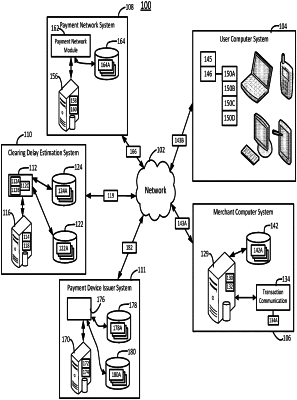| CPC G06Q 20/401 (2013.01) [G06N 5/046 (2013.01); G06N 20/00 (2019.01); G06Q 20/023 (2013.01); G06Q 20/102 (2013.01); G06Q 20/405 (2013.01); G06Q 20/4097 (2013.01)] | 16 Claims |

|
1. A computer-implemented method using a server including a processor and a memory with processor-executable instructions for:
receiving, through one or more processors of an input processor coupled to the server and memory and from a communication module of a merchant computer system over a computer network, a purchase transaction at a merchant;
correlating the purchase transaction to a known outcome associated with a time aggregation of clearing delays, wherein the clearing delays are each associated with different payment transactions between a plurality of customers and a plurality of merchants, and each different payment transaction includes an indication of a clearing delay;
determining a clearing delay estimate for the purchase transaction based on the correlation between the purchase transaction and the known outcome;
inserting the clearing delay estimate into a communication corresponding to an authorization process for the purchase transaction, wherein the communication is between a payment network system and a payment device issuer system, and the payment device issuer system is communicably linked to the merchant computer system;
determining an expected payable amount based on the time aggregated clearing delay estimate;
modifying the authorization process based on the clearing delay estimate of the communication by approving or denying the purchase transaction when the expected payable amount is above or below a threshold payable amount, respectively; and
in response to the clearing delay estimate being above a threshold time, automatically adjusting funds available to disperse to the plurality of merchants based on the clearing delay estimate.
|